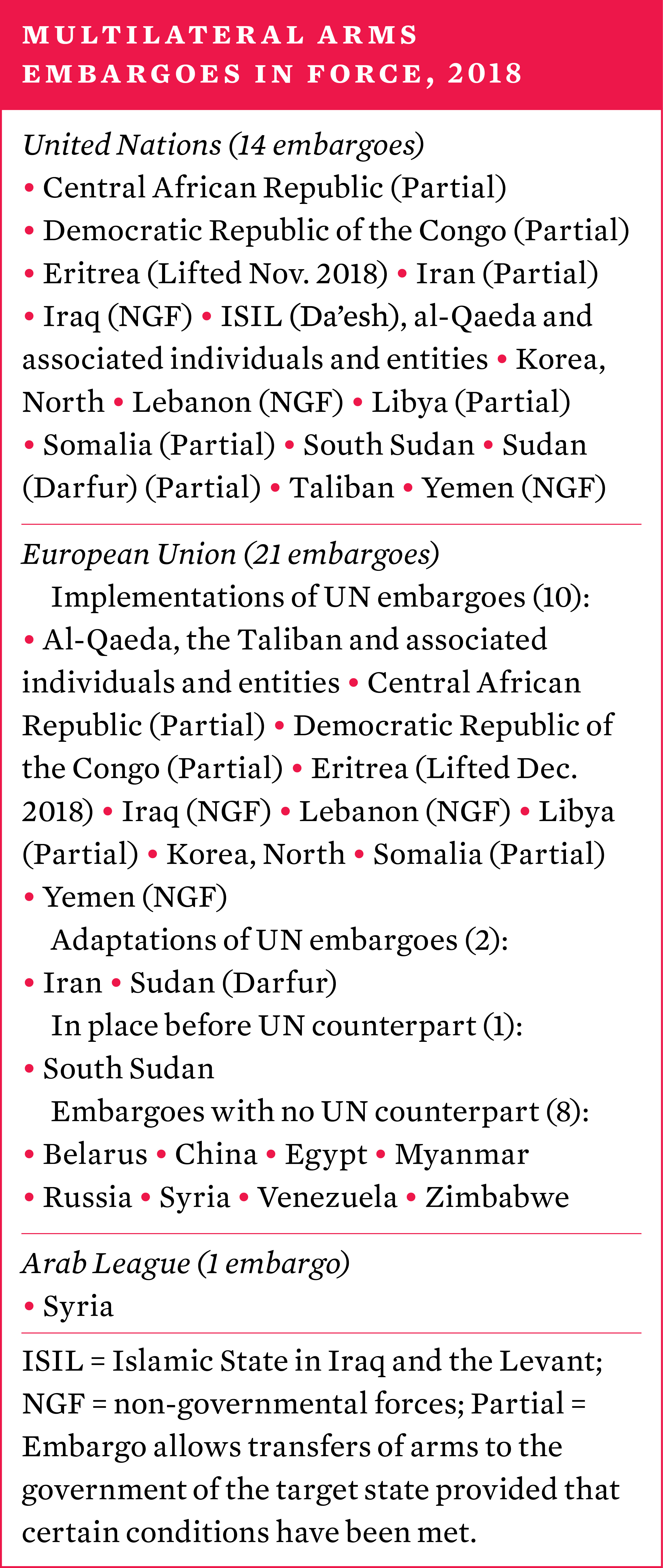10. Dual-use and arms trade controls
Overview, Mark Bromley [PDF]
I. The Arms Trade Treaty, Mark Bromley, Kolja Brockmann and Giovanna Maletta [PDF]
II. Multilateral embargoes on arms and dual-use items, Mark Bromley and Pieter D. Wezeman [PDF]
III. The export control regimes, Giovanna Maletta, Sibylle Bauer, Kolja Brockmann and Mark Bromley [PDF]
IV. Developments in the European Union’s dual-use and arms trade controls, Mark Bromley and Giovanna Maletta [PDF]
V. Controlling technology transfers and foreign direct investment: the limits of export controls, Mark Bromley and Kolja Brockmann [PDF]
Global, multilateral and regional efforts continued in 2018 to strengthen controls on the trade in conventional arms and in dual-use items connected with conventional, biological, chemical and nuclear weapons and their delivery systems. There were growing signs that the strength of these instruments is being increasingly tested by stretched national resources. This could be seen in the shortfalls in compliance with mandated reporting under the 2013 Arms Trade Treaty (ATT), the many reported violations of United Nations arms embargoes and the difficulties in finding states willing to act as chair of some of the export control regimes. Broader geopolitical tensions and the rapid pace of technological advances are also eroding international consensus on both the broader purpose and the effectiveness of export controls.
The Arms Trade Treaty
The Fourth Conference of States Parties to the ATT took place in Tokyo in August 2018. While the conference was focused on the topic of diversion, it was also forced to spend a considerable amount of time discussing the administration of the trust fund that supports the participation of low-income states and other aspects of treaty architecture. Moreover, levels of compliance with the ATT’s reporting and funding obligations continued to fall short in several areas, posing clear challenges to the long-term relevance and health of the treaty. Efforts to achieve universalization have made some progress in recent years and by the end of 2018 the treaty had 100 states parties. Membership remains unbalanced geographically, however, with Europe, Africa and the Americas most heavily represented. The Middle East and North Africa has some of the lowest levels of engagement with the ATT, despite being a region in evident need of stronger controls on arms transfers.
Multilateral arms embargoes
In 2018 there were 36 multilateral arms embargoes in force: 14 imposed by the UN, 21 by the European Union (EU) and 1 by the League of Arab States. Of the EU’s 21 embargoes, 10 implemented UN arms embargoes directly, 1 was put in place before an equivalent UN embargo was imposed, 2 were similar to UN embargoes but differed in geographical scope or the types of weapon covered and 8 had no UN counterpart. Most of these embargoes only covered conventional arms. However, the UN and EU embargoes on Iran and North Korea, and the EU embargoes on Russia and Syria also covered exports of dual-use items.
One new multilateral arms embargo was imposed in 2018: a UN embargo on South Sudan. The UN and EU arms embargoes on Eritrea, imposed in 2009, were lifted. As in previous years, investigations by the UN revealed problems with the implementation of its embargoes, and numerous reported cases of violations. However, the scope and significance of these violations varied considerably. Some involved large shipments of arms in contravention of the embargo while others involved a failure by a supplier or recipient state to notify a sanctions committee about a transfer.

Export control regimes
Membership of the four multilateral export control regimes—the Australia Group (AG), the Missile Technology Control Regime (MTCR), the Nuclear Suppliers Group and the Wassenaar Arrangement on Export Controls for Conventional Arms and Dual-use Goods and Technologies (Wassenaar Arrangement, WA)—remained stable following recent expansions. During 2018, all four regimes reviewed their respective trade control lists and guidelines. As in previous years, commonalities among the regimes centred around keeping up with technical developments and illegal procurement efforts—helped by an increase in inter-regime engagement on these issues.
The EU is the only regional organization to have established a common legal frame-work for dual-use and—to a more limited extent—arms export controls. In 2018 the EU institutions continued work on the ‘recast’ of the EU Dual-use Regulation and began work on a review of the EU Common Position on Arms Exports. In both cases, the European Parliament and non-governmental organizations sought to expand their scope—particularly by strengthening language on human rights and international humanitarian law. Some EU member states opposed these suggested changes.
Controlling technology transfers
In 2018 the United States, the EU and a number of EU member states increased the use of controls on foreign direct investment (FDI) to regulate transfers of ‘sensitive’ or ‘strategic’ technology. Long-standing challenges to the efficacy of export controls have been compounded by rapid advances in military-relevant emerging technologies in the civilian sector and the growing levels of foreign investment in the companies and research institutes involved. However, attempts to use FDI regulations to place restrictions on the trade in technology may come to be seen as further evidence of the willingness of states to use export controls to further their own economic interests. In the long term, such attempts may undermine the value of export controls as a multilateral tool for, among other things, preventing destabilizing transfers of arms and dual-use items.